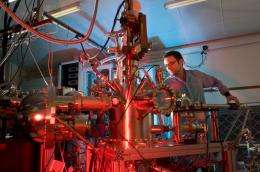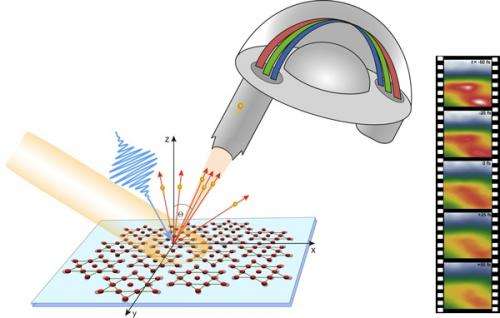Extreme ultraviolet movies reveal inside story of complex materials

(PhysOrg.com) -- A new X-ray movie technique using extreme ultraviolet (XUV) pulses from Artemis (link opens in a new window), one of the world's most advanced lasers, could help unravel the mysteries of phenomena such as magnetism or high-temperature superconductivity. The results are published in the latest edition of Physical Review Letters.
The new materials science beamline at Artemis has succeeded in making movies of electronic and structural changes in a complex material using XUV pulses produced through high harmonic generation, a technique where a laser is fired into a gas jet and just one part in a million is converted into XUV pulses.
Members of the international collaboration from the STFC Central Laser Facility, Diamond Light Source and the universities of Hamburg, Lausanne, Oxford and Padua used these XUV pulses to study a layered crystal of Tantalum Disulphide. The resulting movies – whose frames captured slices of time lasting less than a millionth of a millionth of a second – revealed that electrical conductivity in this material is governed by strong interactions between the electrons themselves.
Understanding this type of ‘correlated-electron’ behaviour is of crucial importance, since it underlies effects such as high-temperature superconductivity. Superconductivity is the phenomenon where electric current can travel through a material with no loss, because the material is a perfect conductor with zero resistance. Although superconductors are widely used, how they work is less well understood. Even high temperature superconductors need to be kept at -170°C, requiring sophisticated cryogenics systems. The world has ever increasing energy requirements and the search is on to find superconductors that work at room temperature. Understanding the complex physics that underlies this phenomenon is the key.
Dr Jesse Petersen of the University of Oxford said, “This is the only technique that enables us to separate several different processes that are taking place within the material at the same time. The result is particularly interesting because it tells us there must be much more new physics in this material than we had originally thought.”
Professor John Collier, Director of STFC Central Laser Facility said: “These excellent results complement work by other research groups who are using the Artemis laser to probe how laser pulses can be used to switch magnetism on and off by looking at electron spin dynamics. If these phenomena can be understood and controlled, it opens the way for new devices and technologies - such as ultra high speed data storage.”

The technique used on Artemis is time and angle resolved photoemission spectroscopy (tr-ARPES) , which enables the electronic structure of a material to be monitored as it responds to excitation by a laser pulse. The target material is irradiated by a short laser pulse, which induces structural changes and excitations. It is then probed at a series of time delays by a short wavelength pulse which generates photoelectrons that are then collected and analysed.
Until recently, tr-ARPES measurements with lasers have typically used only near UV radiation (<7 eV) and pulses of 100 fs or longer. The low photon energy meant that only a small subset of electrons, with certain energies and travelling in certain directions, could be ejected from the material and detected. The long pulselength meant that it was impossible to see the fastest changes to the material.
The Artemis beamline is one of the first in the world to overcome these limitations by using XUV pulses from high-order laser harmonics, with 20 eV photon energy and 30 fs time resolution. XUV pulses are created through the technique of high harmonic generation. A short pulse laser is focused into a gas-jet and interacts with the gas, producing even shorter pulses of coherent radiation in the 10-100 nm wavelength range. The higher photon energy enables electrons with a much wider range of energy and momentum space to be detected, meaning that each snapshot of electronic structure has a much wider field of view.
ARPES is also widely used on synchrotrons, using similar photon energies, to make high resolution static maps of electronic structure. A new ARPES beamline is now in construction at Diamond Light Source, meaning that scientists will be able to use these two very complementary techniques located on one site.
These experiments focussed on the layered material tantalum disulphide (TaS2). A short infrared laser pulse induced a phase transition from a Mott insulator to a metal, and then XUV pulses recorded a sequence of snapshots of the electronic structure on a very short timescale. TaS2 exhibits a ‘charge density wave’ – a regular variation in electron density across the layers of atoms – which makes the atoms settle into star-shaped patterns.
Charge density waves are normally related to interactions between electrons and the crystal structure, while Mott insulators are instead produced by interactions between the electrons themselves. The experiment found that, contrary to expectations, the charge density wave and Mott-insulating states ‘melted’ simultaneously, suggesting a novel mechanism for charge density waves in this material.
The X-ray movies also revealed a structural relaxation which followed the electronic phase transition, but moving slightly more slowly.. This was only possible because of the improved time resolution and higher photon energy in the Artemis beamline. The technique looks to be a promising route to disentangling the complex behaviour of exotic materials.
More information: prl.aps.org/abstract/PRL/v107/i17/e177402
Provided by Science and Technology Facilities Council




















